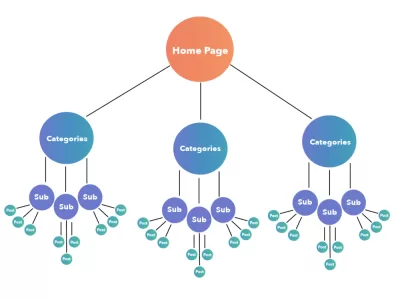Table of Contents
Optimizing user experience for ecommerce SEO (search engine optimization) gets your website to rank high on search engines, which is crucial for success. However, simply optimizing your website for search engines is not enough. You need to focus on user experience to truly stand out from the competition. In fact, user experience plays a vital role in e-commerce SEO and can significantly impact your website’s search engine rankings.

The process of optimizing user experience for ecommerce SEO can make or break your website’s success. If your website provides a poor user experience, visitors are more likely to bounce off your site, resulting in a high bounce rate. A high bounce rate sends a negative signal to search engines, which can negatively impact your search engine rankings. On the other hand, a website that provides a seamless, user-friendly interface and experience is more likely to keep visitors engaged and on your site, which can lead to higher search engine rankings.
Optimizing user experience for ecommerce SEO involves a variety of strategies. From simplifying your website’s URL structure to providing personalized interactions and customer reviews, there are many ways to improve your website’s user experience and, in turn, boost your search engine rankings. By prioritizing user experience in your ecommerce strategy, you can set your website up for sustained success.
Understanding Ecommerce SEO
If you are running an online store, you must be familiar with the term “ecommerce SEO.” It is a set of optimization techniques that enable your website to rank higher in search results. With the right SEO strategies, you can appear in more relevant search results, which enables you to drive more traffic, leads, and sales to grow your store online.
The Role of SEO in Ecommerce
SEO plays a crucial role in the success of an online store. When someone searches for a product or service that you offer, you want to be one of the top results that come up on search engines like Google. A higher ranking means more visibility and traffic to your website, which can lead to more sales.

However, it’s not just about ranking higher on search engines. It’s also about providing a good user experience to your customers. Google’s algorithms are designed to reward websites that provide a positive user experience. This means that your website should be easy to navigate, load quickly, and provide relevant and useful information to your customers. As a result, by optimizing your user experience for ecommerce SEO using these strategies will help you improve engagement, increase sales, and boost SEO rankings.
Key SEO Strategies for Online Stores
There are several key strategies for optimizing user experience for ecommerce SEO that you should implement to improve your online store’s visibility and user experience:
- Keyword research: Identify the high-value search keywords that drive organic traffic for your niche. Use these keywords in your website content, meta tags, and product descriptions to improve your website’s relevance and visibility.
- Optimize website structure: Make sure your website is easy to navigate and has a clear hierarchy. Use internal linking to help users find what they are looking for quickly.
- Write SEO-friendly content: Create high-quality, informative content that is optimized for search engines. Use headings, subheadings, and bullet points to make it easy to read.
- Build backlinks: Get other websites to link back to your website. This can improve your website’s authority and help it rank higher in search results.
- Provide a good user experience: Make sure your website is mobile-friendly, loads quickly, and is easy to use. Provide clear product descriptions and images to help customers make informed decisions.

User experience makes a whole difference in ecommerce SEO. Implementing these strategies is a sure way for optimizing user experience for ecommerce SEO and ensuring your online store’s visibility, which can lead to more traffic, leads, and sales.
1. Optimizing Site Structure and Navigation
When it comes tooptimizing user experience for ecommerce SEO, your site’s structure and navigation is critical to providing a seamless user experience. A well-organized site structure and navigation can help users find what they’re looking for quickly and easily, which can lead to increased conversions and sales. Here are some tips for optimizing your site structure and navigation:
Creating a User-Friendly URL Structure
Your URL structure plays a vital role in your ecommerce SEO efforts. A simple and user-friendly URL structure can make it easier for users to understand what your page is about and help search engines crawl and index your site more efficiently. Here are some best practices for creating a user-friendly URL structure:
- Keep it simple and concise. Avoid using long and complicated URLs that are difficult to read and remember.
- Use relevant keywords in your URL. Including relevant keywords in your URL can help search engines understand what your page is about and improve your search engine rankings.
- Use hyphens to separate words. Using hyphens to separate words in your URL can make it easier to read and understand.
Effective Use of Categories and Subcategories

Categories and subcategories are essential for organizing your products and making it easier for users to find what they’re looking for. Here are some best practices for using categories and subcategories effectively:
- Keep your category structure simple and intuitive. Avoid creating too many categories and subcategories, as this can overwhelm users and make it difficult to find what they’re looking for.
- Use descriptive and relevant category names. Using descriptive and relevant category names can help users understand what products are included in each category and make it easier to find what they’re looking for.
- Use breadcrumbs to show users where they are on your site. Breadcrumbs can help users understand where they are on your site and make it easier to navigate back to previous pages.
By impeoving your site structure and navigation, you are optimizing user experience for ecommerce SEO in a way that can lead to increased conversions and sales. Keep these tips in mind when designing your e-commerce site to ensure that your users can find what they’re looking for quickly and easily.
2. Enhancing Product Pages for Better Visibility
Optimizing user experience for ecommerce SEO also requires you to pay attention to product pages since they play a significant role in driving traffic and sales. Optimizing product pages for better visibility is crucial to attract potential customers and improve your conversion rate. In this section, we will discuss two essential elements that can enhance your product pages for better visibility.
The Importance of High-Quality Product Images
High-quality product images are crucial to attract potential customers and improve your conversion rate. Images are the first thing that customers see when they visit your product page, and they can make or break a sale. Therefore, it is essential to use high-quality images that showcase your products in the best possible light.

Make sure that your product images are clear, well-lit, and show the product from different angles. You can also use zoom-in functionality to allow customers to see the product in greater detail. Additionally, you can use lifestyle images to help customers visualize how the product looks in real life.
Crafting Compelling Product Descriptions
Product descriptions are an essential element of your product page and for optimizing user experience for ecommerce SEO. They provide customers with important information about the product, such as its features, benefits, and specifications. A well-crafted product description can help customers make an informed purchase decision and improve your conversion rate.
When crafting your product descriptions, make sure to use language that is clear, concise, and easy to understand. Use bullet points to break up long paragraphs and make the information more digestible. Additionally, use keywords that are relevant to your product to improve its visibility on search engines.
In summary, optimizing your product pages for better visibility is crucial to attract potential customers and improve your conversion rate. By using high-quality product images and crafting compelling product descriptions, you can create a product page that stands out from the competition and drives sales.
3. Leveraging Content Marketing and SEO
Optimizing user experience for eommerce SEO and improving your website’s search engine ranking also needs you to focus on creating high-quality and optimized content. By leveraging content marketing and SEO, you can increase your website’s visibility and drive more traffic to your site.

Incorporating a Blog to Boost Authority
One way to incorporate content marketing into your eommerce SEO strategy is by creating a blog. A blog can be a valuable tool for increasing your website’s authority and establishing your brand as a thought leader in your industry. By regularly publishing high-quality blog posts, you can attract more visitors to your site and keep them engaged with your brand.
To make the most of your blog, you must optimize your posts for SEO. This means conducting keyword research to identify the terms and phrases your target audience is searching for and incorporating them into your blog posts. You should also make sure your blog posts are well-written and provide value to your readers.
Utilizing SEO-Friendly Content Strategies
Optimizing user experience for ecommerce SEO through content marketing does not end with incorporating a blog into your content marketing strategy. You must also focus on creating SEO-friendly content. This means creating content that is optimized for search engines and provides value to your readers.

To create SEO-friendly content, you must conduct keyword research to identify the terms and phrases your target audience is searching for and incorporate them into your content. You should also make sure your content is well-written, informative, and engaging.
Other SEO-friendly content strategies include creating product descriptions that are optimized for search engines, incorporating user-generated content into your site, and creating video content that is optimized for search engines.
By leveraging content marketing and SEO, you can improve your ecommerce website’s search engine ranking and drive more traffic to your site. By incorporating a blog into your content marketing strategy and utilizing SEO-friendly content strategies, you can establish your brand as a thought leader in your industry and attract more visitors to your site.
4. Maximizing User Engagement and Conversions
Prioritizing user engagement and conversions is also an element of optimizing user experience for ecommerce SEO. By focusing on these metrics, you can increase your website’s visibility and revenue. In this section, we will explore two ways to maximize user engagement and conversions: improving site speed and mobile responsiveness, and enhancing user trust through reviews and trust signals.
Improving Site Speed and Mobile Responsiveness
Site speed and mobile responsiveness are critical factors that can impact user engagement and conversions, translating to optimizing user experience for ecommerce SEO. According to Salesforce, a one-second delay in page load time can lead to a 7% reduction in conversions. Furthermore, with the rise of mobile devices, it is essential to ensure that your website is optimized for mobile users.

To improve site speed, you can:
- Optimize images and videos to reduce their file size.
- Minimize HTTP requests by combining multiple files.
- Use a content delivery network (CDN) to distribute your website’s content across multiple servers.
To optimize your website for mobile users, you can:
- Use responsive design to ensure that your website adjusts to different screen sizes.
- Avoid using pop-ups and interstitials that can disrupt the user experience.
- Optimize your website’s font sizes and button sizes for mobile users.
Enhancing User Trust Through Reviews and Trust Signals
User trust is a crucial factor that can impact user engagement and conversions. According to Business Tech Weekly, 95% of consumers read online reviews before making a purchase. By showcasing positive reviews and trust signals, you can enhance user trust and increase conversions.
To enhance user trust, you can:
- Encourage customers to leave reviews by sending follow-up emails after a purchase.
- Display customer reviews prominently on your website.
- Highlight trust signals such as security badges and social proof.

By improving site speed and mobile responsiveness and enhancing user trust through reviews and trust signals, you can maximize user engagement and conversions on your e-commerce website.
In conclusion, optimizing user experience for ecommerce SEO simply refers to making it easy to use for your customers and potential customers. When this is not the case, your website will experience a high bounce rate, which will have a negative impact on ecommerce SEO. Further, optimizing user experience for ecommerce has a direct impact on your online business’s return on investment.







